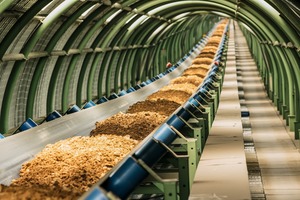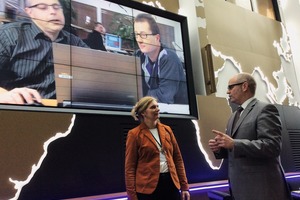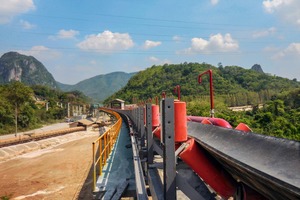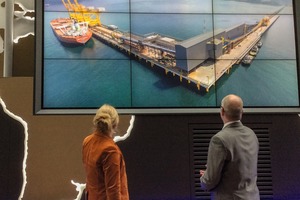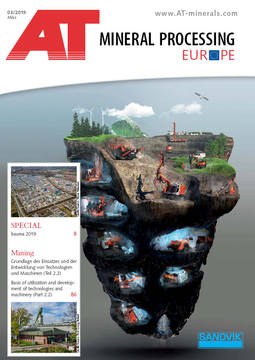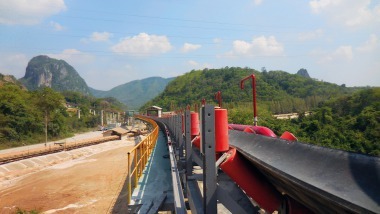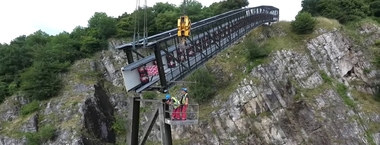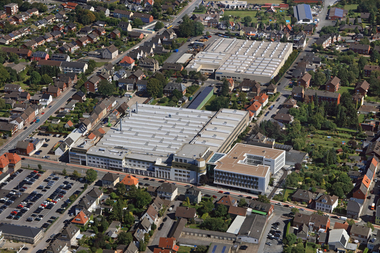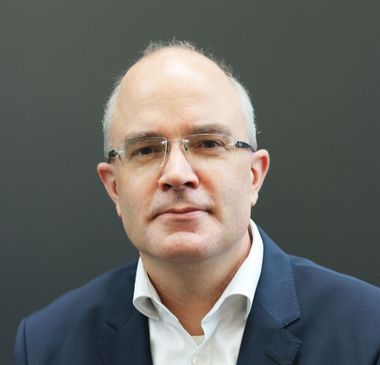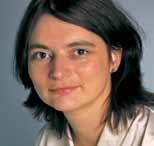Complex system solutions for different industries such as mining or the cement industry
Dr. Andreas Echelmeyer has been head of the Center of Competence for Conveying and Loading Systems at BEUMER Group GmbH & Co. KG in Beckum since mid‑2016. In a conversation with Dr. Echelmeyer, Dr. Petra Strunk, Editor-in-Chief at AT MINERAL PROCESSING, learned exactly how the new facility has developed during the past 3,5 years and what diverse tasks are being performed by the staff at this competence center.
AT: How was your start in this new field?
Dr. Echelmeyer: Initially, my work consisted, above all, of listening, watching and understanding the procedures. You take things very seriously, coming from outside, and you question tried-and-proven practices. For the first six months, I mainly took care to obtain a precise picture of the actual state of things, after which I began to reshape the department.
AT: What tasks does the Center of Competence for Conveying and Loading Systems perform, and for what segments of industry is it responsible?
Dr. Echelmeyer: The Center of Competence is not aimed at any particular sector of industry, and we can work on extremely diverse projects, in the fields of mining, or power plants, for example, cement industry projects and harbour handling systems. Our work starts as soon as a customer wishes to implement a complex major project in the field of bulk materials handling. We then firstly discuss the assignment with him. It is vital that we ask the right questions, to enable us, ultimately, to provide a precisely tailored solution.
AT: Why was this new department set up in 2016 in particular – was there a specific reason?
Dr. Echelmeyer: The implementation of the large-scale Vale Project (see AT 04/2015) resulted in Beumer deciding to also again place greater emphasis on major projects in the company‘s portfolio. This was the foundation for the creation of this new department, our active entry to the market and also our decision to supply solutions for large-scale projects. Previously, we had tended more to react to customer‘s enquiries, whereas now we approach the customer proactively.
AT: What makes the Center of Competence for Conveying and Loading Systems different?
Dr. Echelmeyer: The Beumer locations used to act independently of one another in this sphere of business, each of them specialising in particular conveying components – we have now grouped all of this together in a single department and are able to offer customers all-in solutions. In addition, we make visits to the various national companies, and we systematically look, globally, at what needs the customers have and try to understand whether the problems are similar around the world, and what needs are more regional.
Beumer has expanded greatly in recent years, and complete groups of companies and new colleagues have been added. The task here is to integrate all the colleagues working in this sector, to define common aims and to actively proceed together. I, as head of the Competence Center, am also responsible for this. The ultimate target of this restructuring is a joint marketing/sales organisation, with a uniform image and a common strategy.
AT: What are the particular aims and challenges when setting up a structure, and how do employees react to such changes?
Dr. Echelmeyer: Development must aim at ensuring that the team has the confidence to do practically anything. The approach must not be “We‘ve never done that before”, but instead, “We‘ve understood the problem and we are working on a solution for it”. This presupposes in the employees an inner willingness to tackle something new – so much self-confidence is essential. There are no longer any standard answers, and the need now is for the employees‘ capabilities and knowledge for the creation of a tailor-made solution. For some employees this will be a new way of working, without doubt – you have to instil in them the courage to think freely and to pursue new paths. My aim is also to back them up wherever I can.
In addition, much more teamwork is needed, and much more interchange between the employees and the individual departments. In processing of projects, the departments must be integrated in the context of customer enquiries at a very early stage. This is a new approach – marketing, the design department, project management, etc. – and all can exercise an influence on the content and execution of projects at an extremely early point.
AT: Do you already have success stories – major project orders?
Dr. Echelmeyer: Absolutely! Our projects have grown larger, whereas, in the past, we would have tended to turn down projects like these. In addition, the customers now specify totally different standards. Our work has become much more international, because our colleagues at the individual locations in Asia and America are more closely involved – they are, after all, the ones who have direct contact with the customer.
AT: When will the establishment of the new department reach an initial conclusion?
Dr. Echelmeyer: We never stop learning, of course, but, at the moment, we already have a very high rate of change, and we need around three years or so for the new to be understood and lived out, the departments established and procedures and processes smoothly implemented.
AT: In what direction will the development of the Competence Center go? What targets are you pursuing?
Dr. Echelmeyer: In the period from 2003 to 2012 there was much rapid investment in the mining sector - and very rapid investments were also absolutely necessary - and the projects were implemented very quickly. The prime need during this phase was speed. There were very many very large projects, with less attention to optimisation and efficiency. I don‘t think there‘ll be a boom like that again in the near future.
At present we‘re looking at the efficiency of things, at emissions, environmental aspects, and costs. We‘re focusing more on optimising large facilities. Haulage of ores using trucks is pretty inefficient, but automated conveying necessitates systems that can cope with uneven and inaccessible terrain. We can supply tried-and-proven solutions in this field. Beumer is a pioneer in this sector, we constructed one of the first curve-capable belt installations globally.
Initially, we implemented cement industry projects, above all. But extremely good and flexible solutions for a range of different terrains are also needed in mining. Beumer is extremely competent in the field of overland haulage. There is a tendency toward ever longer belt systems. The development of belt installations to bridge long distances is coming ever more to the fore, because the use of trucks is extremely complex and costly, and also causes environmental problems.
AT: The development of automatic monitoring systems will then surely be another necessary step, particularly in difficult terrain?
Dr. Echelmeyer: Manual supervision of the belt is no longer a practical proposition, even for a belt length of only 10 km. Rational condition monitoring is an integral part of these belt systems, and relieving the customer of this task is also a key function for us. So supervision is performed by appropriate monitoring systems. Smart belts can also relay the Actual condition to the control systems, making it possible to forecast the necessity for maintenance work in advance.
AT: Where do you see future challenges for your sector?
Dr. Echelmeyer: In addition to the trend toward ever longer belt systems, the time factor is also playing an ever greater role. We recently had a project which necessitated the removal of an old landfill. These are projects on which we have to react quickly, because the material has to be relocated or reprocessed within very short periods. In addition, there is also a greater demand for equipment which is used only temporarily at any specific site. Modular designs can play a decisive role in this context.
AT: Will there be any totally new technical solutions?
Dr. Echelmeyer: One exciting factor in this respect is that we have positioned ourselves so broadly – we provide solutions for the cement industry, the coal and ore processing sector, and also for the foodstuffs industry. We have to be careful not to lose the overall picture, of course, but it is, on the other hand, also extremely interesting to develop systems and draw up concepts for so many different fields – it could be that this also results in cross-fertilisation and new solutions. I‘m very much looking forward to seeing what the future will bring.

